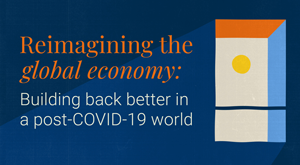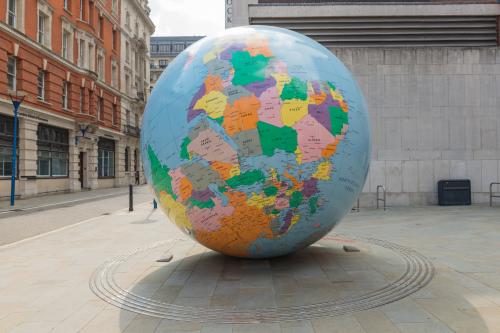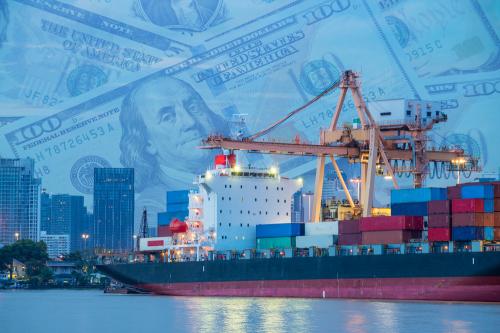This essay is part of “Reimagining the global economy: Building back better in a post-COVID-19 world,” a collection of 12 essays presenting new ideas to guide policies and shape debates in a post-COVID-19 world.
 The issue
The issue
The COVID-19 pandemic and associated global recession have had a devastating effect on international trade. In the second quarter of 2020, global trade was down 18.5 percent, a far sharper drop than was seen for GDP.1 Much of the economic activity that continues in a pandemic—health services, housing services, utilities—is not traded internationally, while the widely traded goods such as cars, electronics, and tourism are cut back as people face an uncertain future. The COVID-19 pandemic comes on top of other issues that were already affecting trade, notably Industry 4.0—the current trend of automation and data exchange in manufacturing technologies, including cyber-physical systems, the internet of things, cloud computing, and smart factories. In the years before the pandemic, merchandise trade was increasing less rapidly than world GDP, breaking a long-standing pattern, though trade in services was rising more rapidly. The declining importance of merchandise trade probably reflected both Industry 4.0 as well as the U.S.-China trade war.
The main question addressed in this essay is, what is the likely evolution of supply chains and international trade in the medium to long run after the COVID-19 pandemic? In other words, once the global economy recovers from the cyclical downturn, are there likely to be permanent changes in global trade? Will these create a more difficult environment for development? What policies at the national and international level can mitigate effects that harm development? These are naturally highly speculative questions, but by thinking of them now, we can potentially mitigate the worst long-run effects of this crisis on development.
China’s exports to the U.S. have gone down, but China’s exports to those other developing countries have gone up.
The ideas
I divide the potential long-run effects on trade into three categories: (1) changes in the structure of demand; (2) acceleration of Industry 4.0; and (3) protectionism dressed up as national security.
As the virus is brought under control globally, especially if there is a reliable and widely available vaccine, life should return towards “normal.” But it is likely to be a new normal. The specifics will be hard to predict but there are likely to be some permanent changes in the structure of demand. People in advanced economies may do more work from home permanently, reducing demand for cars and gasoline. We may have less demand for office and retail space. Those changes would tend to put downward pressure on commodity prices and trade volumes. Three industries with extensive value chains involving developing countries are autos, electronics, and clothing.2 I would expect more demand for electronics and less for autos and clothing in a post-pandemic world. But the general point is that there could be large shifts in these industries that affect development opportunities. In terms of services, international tourism may not fully recover to its previous level; this has been an important export for many developing countries. On the other hand, demand for healthcare, childcare, and elderly care is likely to rise; these are all immigrant-intensive industries in advanced economies so demand for migrant workers may well increase.
The pandemic will probably accelerate the spread of Industry 4.0. The idea that everything was going to be done by robots was never realistic, as there are many activities where it is not cost effective to deploy an expensive robot. Garment sewing is still done primarily by people, in the developing world, as are many fine tasks in the electronics and auto value chains. But the pandemic has to change the cost calculation at least to some extent. Imagine an activity where it is slightly less expensive to hire workers in the developing world compared to deploying a robot in an advanced economy. Now firms are aware of potential disruption from pandemics and/or trade blockages. With that risk factored in, the robot may now be the cost-effective choice. Industry 4.0 is not suddenly eliminating manufacturing opportunities in developing countries, but it has to be constraining them, and more so after COVID-19 than before.
Probably the biggest risk for trading opportunities in the developing world is growing protectionism in more advanced economies, often dressed up as national security protection. The U.S. introduced serious protection before the pandemic, most of it aimed at China. Heading into the recession, the U.S. was taxing about half of imports from China at a 25 percent rate. In the short run, this actually created new opportunities for other developing countries. A certain amount of final assembly in garments, footwear, and electronics shifted to countries such as Vietnam, Indonesia, and Mexico. These tend to be the most labor-intensive tasks, and higher wages in China were already driving this production abroad even before the trade war started. What we can observe in the data is that China’s exports to the U.S. have gone down, but China’s exports to those other developing countries have gone up. ASEAN has now moved into first place as China’s biggest trade partner while the U.S. has dropped to #3 (with the EU at #2).3 China has moved into the middle of many value chains, producing machinery and medium-tech components, which are then exported to the countries doing final assembly.
Probably the biggest risk for trading opportunities in the developing world is growing protectionism in more advanced economies, often dressed up as national security protection.
The danger now is that the U.S. will expand its protectionism, since the tariffs aimed at China have not met any of its objectives. The U.S. trade deficit continues to rise, which is to be expected because it is not directly affected by tariffs but rather is the difference between investment and saving. Overall U.S. saving has gone down because of the huge fiscal deficit, the correct policy in this crisis economy but one that tends to increase the trade deficit. There has also been no re-shoring so far of manufacturing back to the U.S., and China’s share of world exports continues to rise. A recent survey of American manufacturers in China found that virtually none are considering relocating back to the U.S., while about one-seventh are considering shifting some production to low-wage countries as described in the previous paragraph.4 These trade war issues now collide with considerations raised by the pandemic. In the U.S. and other advanced economies, it became an issue that much protective gear and pharmaceuticals are coming from China (and India to a lesser extent). So, there is talk now of using government procurement to force production of these items at home.
There is also a risk of rising protectionism in China. Facing the risk of an increasingly closed global trading system, China has announced a policy of “dual circulation.” What exactly this entails is not clear; it may simply reflect a recognition that exports cannot play the same role as in the past and that China needs to bolster household income and consumption, which would be a healthy development that creates new trading opportunities for China’s partners. But it also may presage a more protectionist policy in which China tries to eliminate imported inputs in its value chains. If both the U.S. and China turn inward, that will create a very poor environment for development. Worst case would be a division of the world into an American sphere and a Chinese sphere with developing countries forced to choose, something that they do not want to have to do.
The way forward
The best hope for addressing all of these risks is new trade agreements that maintain an open trading system. There are some positive developments here. China has reached an agreement with ASEAN plus Australia, Japan, New Zealand, and South Korea on a Regional Comprehensive Economic Program. This is not a particularly deep agreement, but it should allow duty-free movement of parts and components, making Asia-Pacific supply chains more predictable and resilient. The Trans-Pacific Partnership (TPP) has also gone ahead and is setting new standards for cross-border data flows, investment, intellectual property rights (IPR) protection, and subsidies. The African Continental Free Trade Area will link 1.3 billion people in 55 countries. Tariffs are not particularly high in Africa so most of the benefit comes from cutting red tape and simplifying customs procedures.5
While these various regional agreements are better than nothing, they risk dividing the world up into different clubs with different rules. Also, the U.S. is not participating in any of them. The ideal in the long run should be an updated WTO agreement that deals with the new issues of cross-border data flows, services, IPR protection, and state enterprises. Intermediate steps could include the U.S. and China (and others) joining TPP or simply a comprehensive trade agreement between China and the United States. This will be politically difficult for any U.S. administration, but it is good policy, nevertheless.
In the short run it also would help to resist the worst protectionist ideas arising from national security concerns. Countries such as the U.S. need to do a better job of preparing for the next pandemic (and other global shocks). But the solution is not to produce everything at home. This will prove to be very costly and will deprive developing countries of production and trading opportunities. For many products such as protective gear, simple medical equipment, and pharmaceuticals, the cost-effective policy will be to have adequate stockpiles. This provides insurance if there is a crisis and problems with global supply chains. Domestic production of these items can be developed quickly if needed; this would be more economic than requiring domestic production in perpetuity, which will be an expensive proposition. This is true for the U.S. and even more important for smaller economies.
The danger of rising protectionism also extends to immigration. As noted, there will be rising demand for migrant labor in the U.S. and other advanced economies as populations age and demand more of various services. Welcoming more immigrants could be win-win and in part substitute for the potential decline in goods trade. Remittances sent back to families are crucial for many developing countries. But it would take more openness than we currently observe in the U.S., Europe, and Japan to realize these win-win outcomes.
-
Footnotes
- “Trade falls steeply in first half of 2020,” World Trade Organization, June 22, 2020, www.wto.org/english/news_e/pres20_e/pr858_e.htm.
- David Dollar at al., “Measuring and analyzing the impact of GVCs on economic development,” Brookings Institution, July 2017, brookings-edu-2023.go-vip.net/research/measuring-and-analyzing-the-impact-of-gvcs-on-economic-development/.
- Ayman Falak Medina, “ASEAN Overtakes EU to Become China’s Top Trading Partner in Q1 2020,” ASEAN Briefing, May 15, 2020, www.aseanbriefing.com/news/asean-overtakes-eu-become-chinas-top-trading-partner-q1-2020/.
- “AmCham Shanghai Releases 2020 China Business Report,” AmCham Shanghai, September 9, 2020, www.amcham-shanghai.org/en/article/amcham-shanghai-releases-2020-china-business-report.
- ”AmCham Shanghai Releases 2020 China Business Report,” AmCham Shanghai, September 9, 2020, www.amcham-shanghai.org/en/article/amcham-shanghai-releases-2020-china-business-report.
The Brookings Institution is committed to quality, independence, and impact.
We are supported by a diverse array of funders. In line with our values and policies, each Brookings publication represents the sole views of its author(s).







